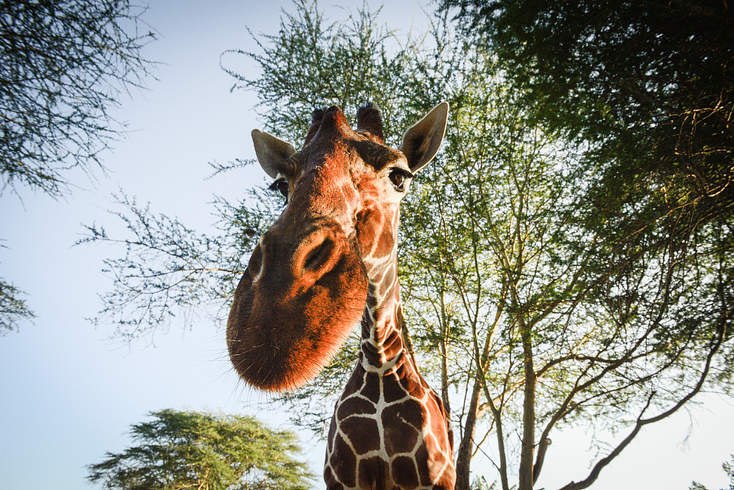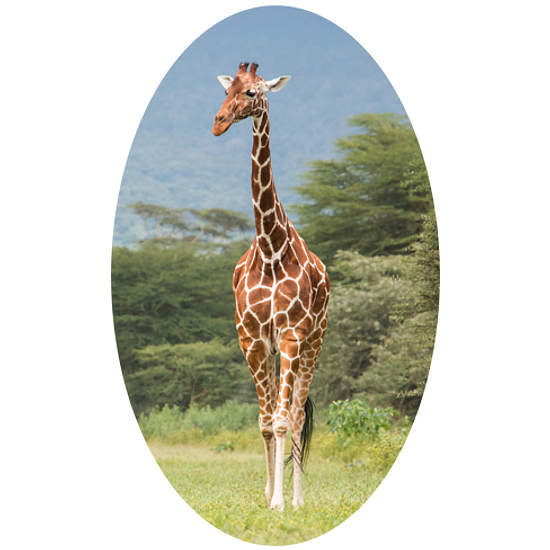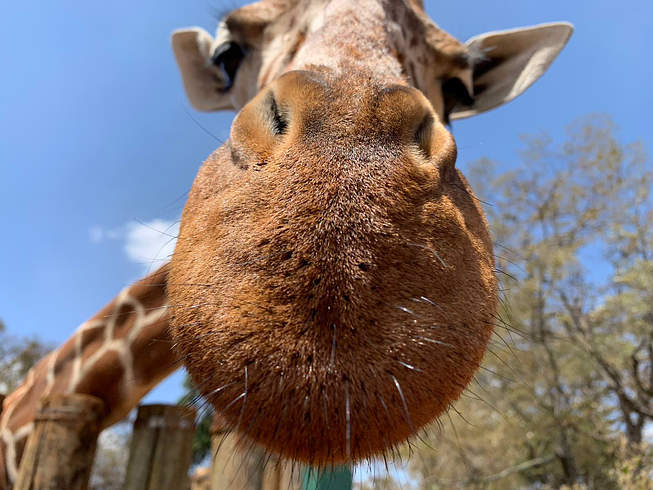
Giraffe
Species we protect
Giraffe
As well as being the tallest animal on earth, giraffes are a keystone species and play an important role in the environment where they live. However, this iconic species faces the biggest threats to its survival due to habitat loss, human population growth, poaching, disease, war and civil unrest.
Fun Facts
Giraffe are fascinating animals. Don't believe us? Find out for yourself...
A giraffe's neck has the same amount of vertebrae (seven) as the human neck, just with each one being up to 25cm long.
Giraffes are the world’s tallest living land animals – adult males can grow to around 5.5m

Giraffes can survive for 2-3 days without drinking water because they get their water from their food and dew on the plants
Giraffes can reach a speed of 60km/hour at gallop over a short distance, and 50km/hour over a longer distance
Giraffe need our protection now more than ever
-
Population
111,000 Giraffe left in Africa. This is a 30% drop on the 1980s
-
2 subspecies
Listed as Critically endangered 2 more subspecies are vulnerable according to the IUCN
Knowing giraffes
Giraffes are highly social animals and live in herds of 15-20 female giraffes and some young males. Male calves will leave their mothers and the herd from around 15 months and join bachelor herds of other young males. The female calves tend to stay with the same herd as their mothers but can leave after the age of around 18 months old, and most often stay in the same areas as the family herd they grew up in.
Females are ready to mate from four years old and have a gestation period of 15 months – at birth, calves endure an incredible drop of 1.5m to the ground! Newborns weigh around 100kg and can be almost 2m tall at birth but their height will almost double within their first year. Newborns need to be so tall when they are born so they can reach up to suckle; they are reliant on their mother’s milk for the first 9-12 months of life but will start eating leaves from 4 months old.
Neck: One of the distinguishing characteristics of a giraffe is its long neck. This allows giraffes to reach the highest leaves and shoots up in the Acacia tree (their favourite food source), which others browsers cannot reach, whilst also keeping an eye out for predators from their vantage point. The neck is also used for ‘necking’ in Bulls. This is a ritualised fight that appears to help establish dominance, and involves repeatedly swinging their neck to deliver head-butts to the other bull on their body and belly. The giraffe’s neck has a very complex system that regulates their blood pressure, ensuring that plenty of blood gets to their brain but not too much when they bend down to take a drink.
Horns: Giraffes' horns are actually known as ossicones and are found in both males and females, they are formed from ossified cartilage and covered in skin and hair. Both males and females are born with their ossicones but they lie flat at birth and are not attached to the skull in order to avoid injury to themselves and the mother, fusing to the skull as they grow older. Interestingly male giraffes often have thicker ossicones than females, which become bald on top due to frequent necking.
Spots: Each giraffe has a pattern of spots that is completely unique to them, much like a humans’ fingerprint. Their spots also have far more use than the obvious camouflage they provide and around each spot is a large blood vessel which branches off in a complex system of blood vessels underneath the spot. A giraffe can send blood through these smaller blood vessels into the middle of each patch to release heat from the body.
Giraffes use very little communication that can be heard by humans. Mothers will occasionally whistle to warn or call their young but most communication is done infrasonically, with moans and grunts far too low for humans to hear. Giraffes also communicate through different positioning of their eyes and will use prolonged stares to warn other members of the herd to danger.
Giraffes are vital to keeping ecosystems in balance. They eat the browse that others cannot reach, which promotes growth of forage and opens up areas for themselves and other smaller browsers to make use of. Importantly this means that by protecting Africa’s giraffes, we are protecting other species too. Giraffes lives are so intertwined with Acacii trees that some seedlings do not germinate until they have passed through a giraffe's digestive system.
Find out how the Sheldrick Wildlife Trust is helping Kenya’s giraffe
Anti-Poaching
Ground teams, accompanied by a canine unit, protect wildlife from illegal activities.
See ProjectMobile Veterinary Units
Six teams and one Sky Vet Unit attend to multiple giraffe cases every year.
See ProjectAerial Surveillance
Aircraft and helicopters monitor wildlife and identify illegal activity
See Project



